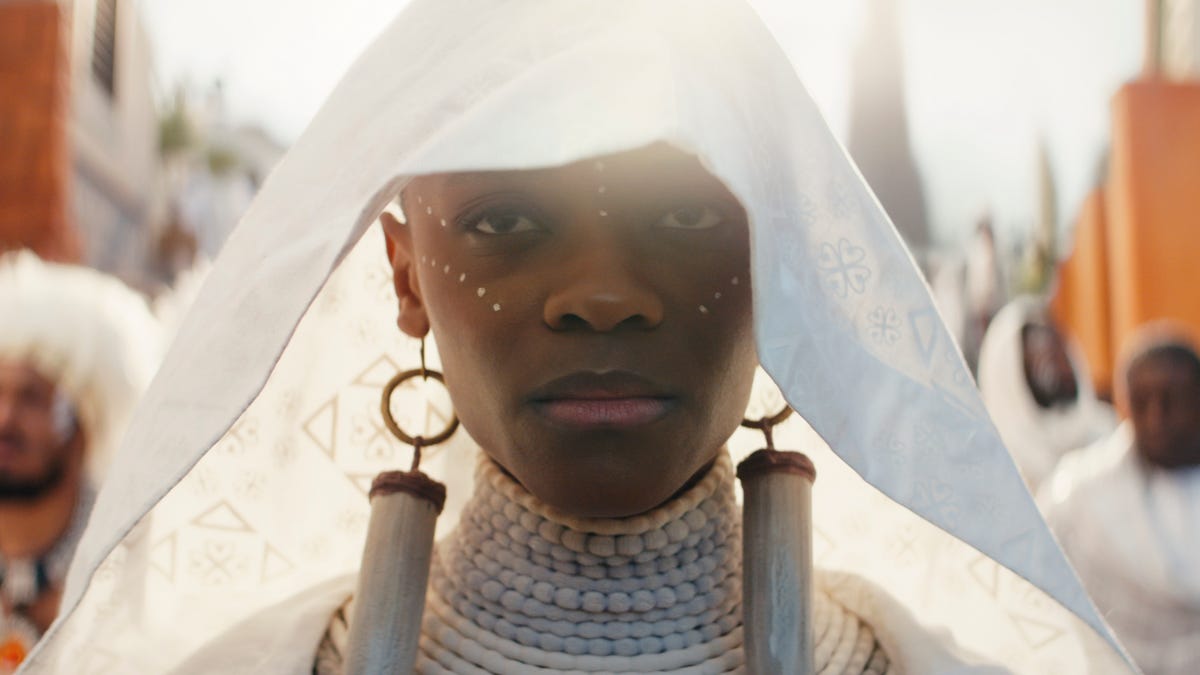Black Panther: Wakanda Forever (dir. Ryan Coogler) is the sequel to Marvel’s Black Panther (2018). Wakanda Forever is exactly what Marvel’s Phase Four of the MCU (Marvel Cinematic Universe) needs to say goodbye to the late Chadwick Boseman (who died in 2020), as well as reintroduce some beloved characters and debut refreshing new ones.
Following the events of Black Panther and high-stakes Avengers: Endgame (2019), the film focuses on Shuri (Letitia Wright), the genius princess of Wakanda who now has to attempt to fill the shoes of her deceased brother T’Challa, and help her mother Queen Ramonda (Angela Basset) protect Wakanda and it’s vibranium. Governments around the world attempt to get a hand on some of the kingdom’s vibranium while Shuri and her mother are confronted by Namor (Tenoch Huerta Mejía), the powerful ruler of the Mesoamerican underwater kingdom of Talokan, who puts the entirety of Wakanda, and the world, in jeopardy. This sends Shuri on a journey along with the help of M’Baku (Winston Duke), Okoye (Danai Gurira), and Nakia (Lupita Nyong’o), to fight to save her people and ultimately herself as she struggles with the grief of losing her beloved brother.
/cdn.vox-cdn.com/uploads/chorus_image/image/71447836/BPL1160_comp_DDO_v0237.1180_R2.6.jpg)
Now to start, Black Panther: Wakanda Forever is a movie meant to be watched with grace.
Director Ryan Coogler, who directed the first beloved Black Panther film in 2018 along with the Rocky spinoff Creed in 2015, has shown that he isn’t afraid to create movies that seem larger than life and center around strong people of color. But during Wakanda Forever, he seems to stumble with the large-scale storytelling while trying to do the character of Black Panther justice in Chadwick Boseman’s absence.

There are times throughout the film when the pacing of the movie seems to drag and often goes from high-paced action to slow, emotional scenes with almost no warning. Shuri’s characterization as the lead character seems inconsistent and confusing at times, although she does get more depth when compared to her secondary role as the smart younger sister in her other film appearances. There is also a subplot to the film revolving around Everett Ross (Martin Freeman) and CIA director Valentina Allegra de Fontaine (Julia Louis-Dreyfus) which seems forced when compared to the size of Shuri’s journey. Moreover, the exit of one of the film’s strongest characters was done at their peak of development, making it unexpected and seems to only continue the universe’s fixation towards using character death as a method of character development.
However, the cinematography is just as stunning as anticipated with a mesmerizing contrast of colors and great camera work that rightfully captures every scene. The fight scenes leave the audience gripping their seats in anticipation and the director’s use of stunts is refreshing when compared to the abused use of CGI in Marvel’s recent films. The costumes also showed amazing amounts of creativity drawing inspiration from African and Mesoamerican cultures and highlighting the diversity being added to Marvel’s expanding universe. Wakanda was bright and lively and there were many scenes filmed underwater, which truly showed the beauty of the vast blue landscapes. Although, the low lighting does make it hard to appreciate some of the finer details at times.

The scene with T’Challa’s funeral was particularly stunning with a parade of citizens displaying their love for their king, bringing tears to the audience who were given the space to acknowledge and grieve Chadwick Boseman’s absence. It is a touching moment and the passing of the baton means handing the spotlight to his sister Shuri, who rightfully shows how she deserves to take center stage.
One of the best things in the film happens to be the introduction of the main antagonist Namor. His entrance into the Marvel Universe was highly anticipated by people of color because of his Mesoamerican heritage, which Is proudly displayed throughout the movie. But what made his character so complex is that he was born during the colonization of Mayan Mesoamerica and most of his ambitions are tied to protecting his people from being taken advantage of again, rather than a self-serving ulterior motive. While the overall resolution of the story was fair, it left many feeling as though he was never the villain at all and was underappreciated by the director of the movie.
/cdn.vox-cdn.com/uploads/chorus_image/image/71614278/wakandaforever_01_marvelstudios.0.jpg)
Another highlight was the introduction of the spunky character Riri Williams (Dominique Thorne). As a young African American prodigy, Riri’s debut is one that not only adds another star to the stellar lineup of Marvel heroes but also shows how inclusive the Marvel Universe is growing to become. And although her costume design in the film is underwhelming when compared to the rest of the cast, her character’s down-to-earth nature also brings in humor that the audience needs to sometimes break the tension during the film.
Overall, the film was long, but a pleasure to watch. It’s action-packed, high-stakes, and one of the most emotionally complex movies of phase four by far. It’s without a doubt that anyone who loved the first Black Panther movie will absolutely love this one.
4/5 Stars
